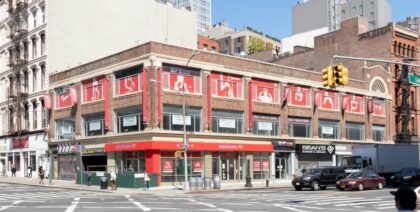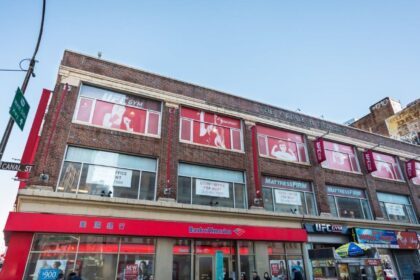Low-rise corner of Canal and Broadway will be preserved and developed
The northeast corner of Canal and Broadway will be redeveloped by United American Land, the folks who own most of that stretch of Canal, as a 13-story residential building with 25 percent affordable housing, all this assuming it gets through the community review and the Landmarks process. The building, which will be known as 277 Canal, is in the SoHo-Cast Iron Historic District Extension.
This is the beginning of what looks like a new era for that corner of Canal.
Architect Morris Adjmi has designed the building, which will be made of textured brick, metal and terracotta and will retain the existing historic façade on the first three floors, keeping the feel of the street level. There will be 100 units in all. The building is right above the N-R station. It was built in 1927 and included a movie theater through the 1970s; it has not been significantly altered since.
UAL has developed and managed more than 20 properties in the neighborhood, including 53 Howard Street, a former department store built in 1857 and recently converted to apartments with ground floor retail anchored by The Guild and Le Mercerie. It has also developed SoHo Mews, the 125,000 square foot condo on West Broadway and Wooster, and received approvals from Landmarks to develop an eight-story retail and office building at 419 Broadway, directly across the street from this site. They also own the bank building on the southwest corner that is now INTER, the immersive art exhibit.
During the height of the pandemic, UAL partnered with Pop-up on Canal to activate 20 vacant retail storefronts with short-term installations from artists, startups and incubators. The company has won the New York Landmarks Conservancy’s top honors for its work at 321/323 Canal, 55 Reade/287 Broadway and 53 Howard.
Here’s the text from the 2010 Landmarks designation report for the district:
This Renaissance Revival-style commercial building, which originally contained a movie theater in addition to retail space and lofts, was built in 1927-28 by the D & D Land Improvement Company a few years after the area around Broadway and Canal Street was established as a major transportation hub by the opening of the Brooklyn-Manhattan Transit line under Broadway. This building includes a subway entrance and passageway on Broadway. The Department of Buildings listed David M. Oltarsh as the architect and general contractor, and applied lettering on the façade bears his name. Upon its completion, the theater was leased to the Major Theater Corp. By 1947, the theater was known as the Giglio-Major Theater, reflecting its proximity to Little Italy. By 1971, it was the Canal Cinema Theater and was serving newer immigrants from the Far East by showing movies from China.
The building’s retail and loft space was rented by a variety of businesses and organizations, including Kruger & Grossmen Men’s furnishings (1931), Kampf & Vaccarella Old Books and Magazines (1936), L. Giuletti & Sons, accordions (1938), Loft Candies (1942), the Bengor Hosiery Company (1950), the International Brotherhood of Teamsters Hall (1954), and the Pearl River Department Store (1990). The building, which remains in commercial use today although the theater is no longer open, is evocative of the changes that were taking place in the SoHo area as a result of transportation improvements and new forms of mass entertainment in the early decades of the 20th Century.















I’m all for any improvements to the Canal-Broadway intersection. Wasn’t there a plan to also develop the opposite (Southwest) corner?
Improvement doesn’t necessarily come in the form of a 13 story building with 75% unaffordable housing.
R: I don’t really understand your comment. It sounds like the building does not currently have any residential units. So the development, in addition to retaining the historic façade, is adding 100 residential units, 25 of which will be “affordable” (however that is defined). Going from zero affordable units to 25 is not an improvement in terms of affordable housing? If you think that the only satisfactory development is one that provides 100% affordable housing, don’t look to the private sector to do that. It’s just not a financially viable option in most, if not all, cases.
How refreshing, for a change, to hear that the new building at the corner of Canal and Broadway “will retain the existing historic façade on the first three floors.” I wish such creative vision had been active when the fine classical-style Fidelity Trust Company building was torn down at the corner of West Broadway and Chambers St. to make room for the banal Smyth Hotel.
My grandfather operated the Major Theater at this property. My father actually worked in the Oltarsh building, which was next to the theater.
I may be interested in any artifacts that could be found for the existence of the theater, including the “M” which was at the top and in the middle of the proscenium–Robert Freedman